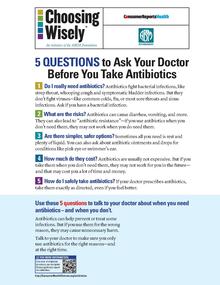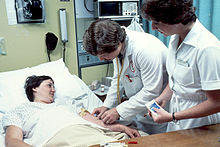Doctor–patient relationship
The doctor–patient relationship is central to the practice of healthcare and is essential for the delivery of high-quality health care in the diagnosis and treatment of disease. The doctor–patient relationship forms one of the foundations of contemporary medical ethics. Most universities teach students from the beginning, even before they set foot in hospitals, to maintain a professional rapport with patients, uphold patients’ dignity, and respect their privacy.
Importance



A patient must have confidence in the competence of their physician and must feel that they can confide in him or her. For most physicians, the establishment of good rapport with a patient is important. Some medical specialties, such as psychiatry and family medicine, emphasize the physician–patient relationship more than others, such as pathology or radiology.
The quality of the patient–physician relationship is important to both parties. The better the relationship in terms of mutual respect, knowledge, trust, shared values and perspectives about disease and life, and time available, the better will be the amount and quality of information about the patient's disease transferred in both directions, enhancing accuracy of diagnosis and increasing the patient's knowledge about the disease. Where such a relationship is poor the physician's ability to make a full assessment is compromised and the patient is more likely to distrust the diagnosis and proposed treatment, causing decreased compliance to actually follow the medical advice. In these circumstances and also in cases where there is genuine divergence of medical opinions, a second opinion from another physician may be sought or the patient may choose to go to another physician.
Michael Balint pioneered the study of the physician patient relationship in the UK with his wife Enid Balint resulting in the publication of the seminal book "The Doctor, His Patient and the Illness." Balint's work is continued by the Balint Society, The International Balint Federation[1] and other national Balint societies in other countries.
In terms of efficacy (i.e. the outcome of treatment), the doctor–patient relationship seems to have a small, but statistically significant impact on healthcare outcomes.[2]
Recognising that patients receive the best care when they work in partnership with doctors, the UK General Medical Council issued guidance for patients "What to expect from your doctor" in April 2013.[3][4]
Aspects of relationship
The following aspects of the doctor–patient relationship are the subject of commentary and discussion.
Informed consent
The default medical practice for showing respect to patients is for the doctor to be truthful in informing the patient of their health and to be direct in asking for the patient's consent before giving treatment. Historically in many cultures there has been a shift from paternalism, the view that the "doctor always knows best," to the idea that patients must have a choice in the provision of their care and be given the right to provide informed consent to medical procedures.[5] There can be issues with how to handle informed consent in a doctor–patient relationship;[6] for instance, with patients who do not want to know the truth about their condition. Furthermore, there are ethical concerns regarding the use of placebo. Does giving a sugar pill lead to an undermining of trust between doctor and patient? Is deceiving a patient for his or her own good compatible with a respectful and consent-based doctor–patient relationship?[7]
Shared decision making

Shared decision making is the idea that as a patient gives informed consent to treatment, that person also is given an opportunity to choose among the treatment options according to their own treatment goals and wishes. A practice which is an alternative to this is for the doctor to make a person's health decisions without considering that person's treatment goals or having that person's input into the decision-making process.
The spectrum of a physician’s inclusion of a patient into treatment decisions is well represented in Ulrich Beck’s World at Risk. At one end of this spectrum is Beck’s Negotiated Approach to risk communication, in which the communicator maintains an open dialogue with the patient and settles on a compromise on which both patient and physician agree. A majority of physicians employ a variation of this communication model to some degree, as it is only with this technique that a doctor can maintain the open cooperation of his or her patient. At the opposite end of this spectrum is the Technocratic Approach to risk communication, in which the physician exerts authoritarian control over the patient’s treatment and pushes the patient to accept the treatment plan with which they are presented. This communication model places the physician in a position of omniscience and omnipotence over the patient and leaves little room for patient contribution to a treatment plan.[8]
Physician superiority
The physician may be viewed as superior to the patient simply because the physician has the knowledge and credentials and is most often the one that is on home ground.
The physician–patient relationship is also complicated by the patient's suffering (patient derives from the Latin patior, "suffer") and limited ability to relieve it on his or her own, potentially resulting in a state of desperation and dependency on the physician.
A physician should at least be aware of these disparities in order to establish a good rapport and optimize communication with the patient. It may be further beneficial for the doctor–patient relationship to have a form of shared care with patient empowerment to take a major degree of responsibility for her or his care.
Benefiting or pleasing
A dilemma may arise in situations where determining the most efficient treatment, or encountering avoidance of treatment, creates a disagreement between the physician and the patient, for any number of reasons. In such cases, the physician needs strategies for presenting unfavorable treatment options or unwelcome information in a way that minimizes strain on the doctor–patient relationship while benefiting the patient's overall physical health and best interests.
Formal or casual
There may be differences in opinion between the doctor and patient in how formal or casual the doctor–patient relationship should be.
For instance, according to a Scottish study,[9] patients want to be addressed by their first name more often than is currently the case. In this study, most of the patients either liked (223) or did not mind (175) being called by their first names. Only 77 disliked it, most of whom were aged over 65.[9] On the other hand, most patients don't want to call the doctor by his or her first name.[9]
Some familiarity with the doctor generally makes it easier for patients to talk about intimate issues such as sexual subjects, but for some patients, a very high degree of familiarity may make the patient reluctant to reveal such intimate issues.[10]
Transitional care
Transitions of patients between health care practitioners may decrease the quality of care in the time it takes to reestablish proper doctor–patient relationships. Generally, the doctor–patient relationship is facilitated by continuity of care in regard to attending personnel. Special strategies of integrated care may be required where multiple health care providers are involved, including horizontal integration (linking similar levels of care, e.g. multiprofessional teams) and vertical integration (linking different levels of care, e.g. primary, secondary and tertiary care).[11]
Other people present
An example of where other people present in a doctor–patient encounter may influence their communication is one or more parents present at a minor's visit to a doctor. These may provide psychological support for the patient, but in some cases it may compromise the doctor–patient confidentiality and inhibit the patient from disclosing uncomfortable or intimate subjects.
When visiting a health provider about sexual issues, having both partners of a couple present is often necessary, and is typically a good thing, but may also prevent the disclosure of certain subjects, and, according to one report, increases the stress level.[10]
Bedside manner

A good bedside manner is typically one that reassures and comforts the patient while remaining honest about a diagnosis. Vocal tones, body language, openness, presence, honesty, and concealment of attitude may all affect bedside manner. Poor bedside manner leaves the patient feeling unsatisfied, worried, frightened, or alone. Bedside manner becomes difficult when a healthcare professional must explain an unfavorable diagnosis to the patient, while keeping the patient from being alarmed.
An example of how body language affects patient perception of care is that the time spent with the patient in the emergency department is perceived as longer if the doctor sits down during the encounter.[12]
Examples in fiction
- Dr. Gregory House (of the show House) has a caustic, callous bedside manner. However, this is an extension of his normal personality.
- In Grey's Anatomy, Dr. Burke compliments Dr. George O'Malley's ability to care for Dr. Bailey's baby by saying "it speaks to a good bedside manner."
- Doc Martin from the Doc Martin British TV series is a good example of a physician with a poor bedside manner.
- Dr Lily Chao from the British TV series Casualty is another example of a Foundation Doctor with a poor bedside manner, whereas her colleague, Dr Ethan Hardy has a better one.
- In Lost, Hurley tells Jack Shephard that his bedside manner "sucks." Later in the episode, Jack is told by his father to put more hope into his sayings, which he does when operating on his future wife. The comments continue in other episodes of the series with Benjamin Linus sarcastically telling Jack that his "bedside manner leaves something to be desired" after Jack gives him a harsh negative diagnosis.
- In Closer, Larry, the physician tells Anna when they first meet that he is famed for his bedside manner.
- In Scrubs, J.D is presented as an example of a physician with great bedside manner, while Elliot Reid is a physician with poor or non-existent bedside manner at first, until she evolves during her tenure at Sacred Heart. Dr. Cox is an interesting subversion, in that his manner is gruff and intense while still inspiring patients to do their own best to aid in the healing process, akin to a drill sergeant. This show also comically remarked that the most amount of time that a doctor needs to be in the presence of the patient before he finds out everything he needs to know is approximately 15 seconds.
- In Star Trek: Voyager, the Doctor often compliments himself on the charming bedside manner he developed with the help of Kes.
- In M*A*S*H, Hawkeye Pierce, Trapper John McIntyre, B.J. Hunnicutt, and Sherman Potter all possess a caring and humorous bedside manner meant to help patients cope with traumatic injuries. Charles Winchester initially possesses no real bedside manner, acting with detached professionalism, until the rigors of his job help him develop a sense of compassion for his patients. Frank Burns has a poor bedside manner, constantly minimizing the seriousness of his patients' injuries, accusing them of cowardice and goading them to return to the front lines.
See also
- Doctor–patient confidentiality
- Medical ethics
- Medical malpractice
- Aggression in healthcare
- Bullying in medicine
- Patient intelligence
- Duty of candor
- Patient abuse
- Physician
- Professional boundaries
References
- ^ "Balint in a nutshell" (PDF). International Balint Federation. February 2007. Retrieved 6 December 2015.
- ^ Kelley JM, Kraft-Todd G, Schapira L, Kossowsky J, Riess H (2014). "The influence of the patient-clinician relationship on healthcare outcomes: a systematic review and meta-analysis of randomized controlled trials". PLOS ONE. 9 (4): e94207. doi:10.1371/journal.pone.0094207. PMC 3981763. PMID 24718585.
{{cite journal}}: CS1 maint: multiple names: authors list (link) CS1 maint: unflagged free DOI (link) - ^ "What to expect from your doctor: a guide for patients". General Medical Council. Retrieved 9 August 2014.
- ^ "Press release: GMC publishes first guide for patients on what to expect from their doctor". General Medical Council. 22 April 2013. Retrieved 9 August 2014.
- ^ "Restructuring Informed Consent: Legal Therapy for the Doctor-Patient Relationship". The Yale Law Journal. 79 (8): 1533–1576. 1970. doi:10.2307/795271.
- ^ Selinger, Christine P. (2009). "The right to consent: Is it absolute?". British Journal of Medical Practice. 2. 2: 50–54. Retrieved 5 March 2012.
- ^ Lichtenberg, P.; Heresco-Levy, U.; Nitzan, U. (2004). "The ethics of the placebo in clinical practice". Journal of Medical Ethics. 30 (6): 551–554. doi:10.1136/jme.2002.002832. PMC 1733989. PMID 15574442.
- ^ Beck, Ulrich. World at Risk. pp. 81–180.
- ^ a b c McKinstry B (October 1990). "Should general practitioners call patients by their first names?". BMJ. 301 (6755): 795–6. doi:10.1136/bmj.301.6755.795. PMC 1663948. PMID 2224269.
- ^ a b Quilliam, Susan (April 2011). "'The Cringe Report': why patients don't dare ask questions, and what we can do about that". J Fam Plann Reprod Health Care. 37 (2): 110–112. doi:10.1136/jfprhc.2011.0060. PMID 21454267.
- ^ Gröne, O & Garcia-Barbero, M (2002): Trends in Integrated Care – Reflections on Conceptual Issues. World Health Organization, Copenhagen, 2002, EUR/02/5037864
- ^ Simple Tips to Improve Patient Satisfaction By Michael Pulia. American Academy of Emergency Medicine. 2011;18(1):18–19.
Further information
- Alexander GC, Casalino LP, Meltzer DO (August 2003). "Patient-physician communication about out-of-pocket costs". JAMA. 290 (7): 953–8. doi:10.1001/jama.290.7.953. PMID 12928475.
{{cite journal}}: CS1 maint: multiple names: authors list (link) - Alexander GC, Casalino LP, Tseng CW, McFadden D, Meltzer DO (August 2004). "Barriers to patient-physician communication about out-of-pocket costs". J Gen Intern Med. 19 (8): 856–60. doi:10.1111/j.1525-1497.2004.30249.x. PMC 1492500. PMID 15242471.
{{cite journal}}: CS1 maint: multiple names: authors list (link) - Alexander GC, Casalino LP, Meltzer DO (March 2005). "Physician strategies to reduce patients' out-of-pocket prescription costs". Arch. Intern. Med. 165 (6): 633–6. doi:10.1001/archinte.165.6.633. PMID 15795338.
{{cite journal}}: CS1 maint: multiple names: authors list (link) - Alexander GC, Lantos JD (2006). "The doctor-patient relationship in the post-managed care era". Am J Bioeth. 6 (1): 29–32. doi:10.1080/15265160500394556. PMID 16423784.
- Pham HH, Alexander GC, O'Malley AS (April 2007). "Physician consideration of patients' out-of-pocket costs in making common clinical decisions". Arch. Intern. Med. 167 (7): 663–8. doi:10.1001/archinte.167.7.663. PMID 17420424.
{{cite journal}}: CS1 maint: multiple names: authors list (link)
External links
- Report of a large summit of patients and physicians, where the ideal patient-physician relationship in the 21st century was discussed. Organised by Johns Hopkins and American Healthways in 2003
- Time Magazine article: "When the patient is a Googler" – Mary Shomons response I II – Trisha Torreys response
